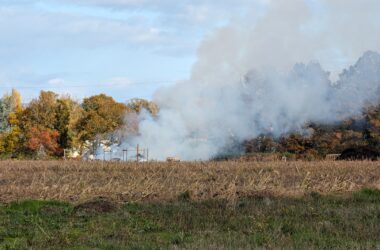Oregon and Washington officials on Friday confirmed that both states have had their first cases of a highly pathogenic bird flu and about 150 backyard chickens, turkeys and geese were destroyed this week.
The disease has been present in North America since at least December and has primarily been spread by migrating waterfowl or scavengers like crows, ravens and raptors, said Colin Gillin, Oregon’s state wildlife veterinarian. It can be transmitted through direct contact or water or food contaminated by saliva or feces.
Bird owners should watch for respiratory disease, ruffled feathers or lethargy or instances of birds suddenly dropping dead. In Oregon, people should call the Oregon Department of Agriculture’s sick bird hotline, 800-347-7028, for domestic birds, or the Oregon Department of Fish and Wildlife’s hotline, 866-968-2600, for reports of sick or dead wild birds. Messages are checked daily.
Gillin said during an online news conference Friday that this year’s strain has been deadlier for wild birds than a 2014-15 outbreak that resulted in the deaths of more than 50 million domestic birds. So far this year, 37 million domestic birds in the U.S. have died of the disease or been killed preemptively because the disease was detected in their flocks.
“All species of birds should be considered susceptible,” Gillin said. “We know that there’s high transmission rates not only among poultry and domestic birds, but also wild birds.”
The current strain does not appear to pose much risk to people. While it’s been detected among birds in at least 34 states, only a single person who worked directly with birds in Colorado has a diagnosed case of bird flu, said Frank Ameduri, a spokesman with the Washington Department of Health. Public health officials are working with wildlife and agriculture officials to monitor potential human exposures.
“It’s very unlikely that it would spread to humans, but if it does we’ll spot it and certainly let you know,” Ameduri said.
Cases in both northwestern states affected backyard flocks. In Oregon, a Linn County woman called Tuesday to report that she had three geese die over the weekend, and the National Veterinary Services Laboratory confirmed yesterday they had bird flu, said Ryan Scholz, state veterinarian with the Oregon Agriculture Department.
Investigators haven’t determined what caused the infection. About 100 birds in that flock, including adult geese, goslings and two guinea fowl, were euthanized Friday.
Washington’s first detection was in a backyard flock of about 50 chickens and turkeys in Pacific County, said Dana Dobbs, a field veterinarian with the Washington State Department of Agriculture.
“One day a crow flew in with some of his chickens, and the next day, he literally described they were dropping like flies,” she said.
The remaining birds were killed Friday after testing by Washington State University and the National Veterinary Services Laboratory confirmed the presence of bird flu. Neither the Washington or Oregon backyard flocks were near commercial chicken farms, and officials don’t yet know how many other animals are at risk.
Oregon farms had about 2.75 million chickens in 2021, according to the Agriculture Department. Poultry is a $15.8 million industry.
People with backyard flocks should keep their animal habitats clean and covered if possible and follow biosecurity guidelines from the U.S. Department of Agriculture, Dobbs said. That includes regularly washing hands, wearing protective boot covers and limiting how many people come in contact with birds.
“The biggest thing is biosecurity,” she said. “This can be birds literally flying overhead or landing amongst the flocks. It’s good if you can bring them under cover if you can, or cover their coops if you can. Clean up any food spills. Limit visitors to the farm, especially if there are other poultry owners.”
So far, the two biggest risk factors in backyard flocks are mixed species and access to ponds or other water sources, even if it’s just a temporary water source like a puddle that birds gather around, said Washington State Veterinarian Amber Itle. Owners should separate their birds by species and limit access to water, she said.
The current strain doesn’t appear to be affecting many songbirds. People with bird feeders or fountains should keep them clean, but don’t need to stop providing bird seed unless they’re attracting waterfowl, said Bryan Richards, emerging disease coordinator at the U.S. Geological Survey’s National Wildlife Health Center.
The 2014-15 strain essentially burned out once migrating birds reached their northern nesting grounds, Richards said. Scientists hope that will happen this year, but they fear it may return as birds migrate south in the fall based on experiences in Europe, which had a similar bird flu in 2021.
Itle agreed that farmers should stay alert this fall, when migrating birds head south. Migrating birds generally pass through Oregon on their way north in April and May and on their way south beginning in September.
“When birds get together, they’re up in Alaska, and they all hang out. they go on dates and those viruses reassort, we never really know what we’re going to get,” she said.
This story originally appeared in the Oregon Capital Chronicle and is republished here under a CC BY-NC-ND 4.0 license. Read more stories at oregoncapitalchronicle.com.






